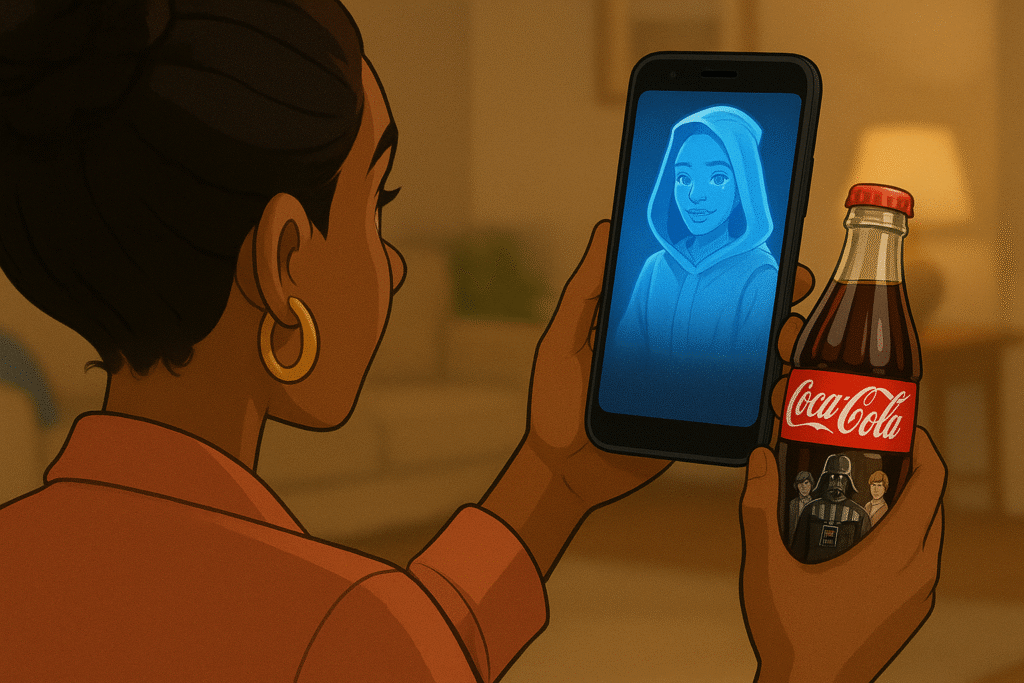
How the galaxy’s most beloved franchise just made QR codes — and Coke — more fun
The Force is strong and sweet with this marketing campaign.
Coca-Cola just launched an experience that lets Star Wars fans create their own hologram transmissions — you know, like Princess Leia’s “Help me, Obi-Wan” message from A New Hope.
All you need is a limited-edition Coke bottle featuring Luke, Vader, Grogu, or The Mandalorian, plus your smartphone camera.
Scan the QR code, record yourself, and BOOM — you’re delivering urgent rebel intelligence in that iconic blue holographic style.

But here’s what makes this cool from a product strategy perspective: QR codes have been essentially dead in North America for over a decade, while thriving everywhere else.
In Asia, I’ve seen QR codes on taxi headrests, napkins, TV commercials, restaurant tables — literally everywhere you can possibly put one. They’re the primary way people pay for everything, connect to WiFi, share contact info and access digital content.
Meanwhile, North American consumers totally ignored them after the initial novelty faded around 2012.
What changed? Context.
The first wave of North American QR codes flopped because they solved problems nobody had.
“Scan this to visit our website!” when typing a URL was just as easy (plus, camera QR integrations didn’t exist yet, so you always had to open a separate app).
“Get our digital brochure!” when nobody wanted your self-serving digital brochure.
Or worst of all, how frequently QR codes dropped a “Page not Found” bomb, punishing adopters.
But Coca-Cola’s Star Wars approach creates genuine value.
Value that can’t be accessed any other way.
You can’t create the hologram experience without scanning the code on a bottle. The physical product becomes the only gateway to something cool, exclusive, and shareable.
This represents a huge shift in how successful brands use technology.
Instead of adding digital features to justify them, they’re creating digital experiences that enhance the core product.
Their Sprite Squad game is an ongoing relationship platform that rewards actual purchases with content, giveaways, and experiences tied to music, sports, and fashion.
Coke’s Oreo collaboration lets friends sync music preferences through Spotify, turning a simple snack into a social connector.
In I Need That, I tell you how products succeed by becoming part of customers’ identity and social interactions. These QR experiences transform consumption into creation and sharing.
The pattern reveals something crucial for product makers: technology becomes compelling when it amplifies existing human desires rather than creating new behaviors.
People already want to share fun experiences with friends.
Star Wars fans already LOVE expressing their fandom.
Friends already want to connect over shared interests.
Coca-Cola made those desires easier to fulfill through its products — and finally gave North American consumers a reason to give a rip about QR codes.
Product Payoff: Nike’s awesome SNKRS app transformed limited sneaker releases from frustrating retail experiences into exclusive digital events. So, instead of camping outside stores, sneakerheads now participate in draws, augmented reality experiences, and gamified releases through the app.
The digital layer made owning limited Nikes feel more special and created ongoing engagement between releases.
It turned product launches into community events, first-time buyers into Nike enthusiasts.
Your technology test: Before adding any digital features to your product, ask yourself whether they AMPLIFY something customers already need to do, or if you’re creating work for them to justify your innovation.
The best product experiences feel effortless because they’re built on natural human behaviors rather than trying to force new habits.
Have you seen digital features that enhanced rather than complicated your experience with a product?
Pop that reply arrow and tell me about a tech experience that actually added value to something YOU already loved.
Or reach out to my team of product marketing strategists at Graphos Product.
